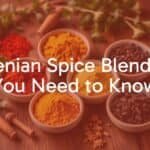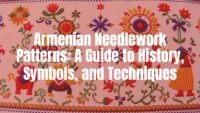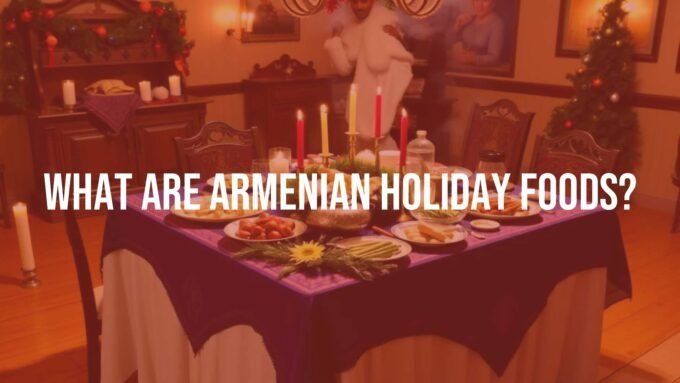Armenian desserts offer layers of flavor, texture, and aroma. These sweets often carry family traditions and a warm sense of welcome. What makes them special is the use of simple, natural ingredients, a sweetness that feels balanced, and a homemade feel passed down through generations. From flaky pastries to cozy puddings, Armenian treats are meant to be enjoyed slowly, often with tea or coffee.

What Defines Armenian Dessert Recipes?
Armenian desserts stand out among global sweets because of their mix of regional influences and long-standing methods. You may notice similarities with Middle Eastern and Russian desserts, yet they keep a clear identity that is Armenian. This comes from specific ingredients, classic techniques, and flavor and texture choices that feel warm and comforting.
Unlike some very fancy or overly sweet desserts, Armenian sweets aim for balance and let the quality of the ingredients shine. They are a key part of gatherings and holidays, reflecting sharing and joy.
Key Ingredients Used in Armenian Sweets
Many Armenian desserts rely on a set of staples common in local cooking. Walnuts are used often, adding rich flavor and crunch to many recipes. From the filling in Gata to the layers in Pakhlava, walnuts appear again and again.
Dairy is also central. Full-fat sour cream and Greek yogurt help create tender doughs and creamy puddings, adding a gentle tang that pairs well with sweetness. Flour, butter, and sugar form the base of many pastries. Spices like cinnamon, nutmeg, and cloves add warm fragrance. Vanilla is common too. Fresh and dried fruits bring natural sweetness, moisture, and bright flavor, especially in fruit-forward cakes and puddings.
| Ingredient Group | Role in Desserts | Examples |
|---|---|---|
| Nuts | Crunch, richness | Walnuts in Gata, Pakhlava |
| Dairy | Tender dough, creaminess | Sour cream, Greek yogurt |
| Spices | Warm aroma | Cinnamon, cloves, nutmeg |
| Fruits | Natural sweetness, moisture | Fresh or dried fruit in cakes |
Traditional Preparation Methods
Armenian dessert making often follows methods taught across generations, with patience and care. Pastries like Gata and Nazook use dough work that creates thin, flaky layers. Techniques such as folding and rolling with butter build the delicate texture many people love. Modern shortcuts exist, but the goal stays the same: light, airy layers.
Baking is the main cooking method. Many sweets bake to a golden color with a lovely smell. Getting the right rise and crumb depends on using yeast, baking soda, and tangy dairy in the right way. For syrupy desserts like Pakhlava, the pastry bakes first, then gets soaked with a sweet, spiced syrup. Even simple rice pudding benefits from slow cooking and steady stirring for a creamy finish.
Common Flavors and Textures in Armenian Desserts
Flavors are cozy and inviting. Sweetness is present but balanced, with spices adding depth. Cinnamon, nutmeg, and cloves appear often, and vanilla brings a classic note.
Textures vary widely. Many pastries have crisp, flaky tops with soft centers. Nuts bring crunch that contrasts with creamy or smooth parts. Puddings and rich cakes feel soft and tender. Some desserts have a light chew, especially fruit-based ones or dense cakes. These contrasts make each bite interesting and memorable.
Popular Armenian Dessert Types
Armenian desserts cover many styles, fit for daily treats and special events. From Gata to Pakhlava, these sweets show a history of shared ideas, clever methods, and a love for good food. Each type has its own mix of ingredients and steps, yet they all share a warm, welcoming feel.
Armenian Pastries: Gata, Nazook, and Their Variations
Gata is a favorite Armenian pastry with many regional names, like “kata,” “gatah,” or “katah.” It sits between cake and bread, lightly sweet with lots of butter. Some versions look like croissants, with thin layers made by rolling enriched dough with an “okhlavoo” (wooden dowel) and shaping spirals. Butter gives them crisp, layered texture.
Other Gata styles are sweeter and more cake-like. They may use yeast or a mix of baking soda and tangy dairy like yogurt or sour cream. A common version is a round disc filled with “khoritz,” a sweet mix of butter, flour, sugar, vanilla, and sometimes nuts, similar to streusel. These are often decorated with dough strips or scored patterns. A yeasted Gata might use Greek yogurt for tenderness, an egg for structure and color, and a little baking soda to lighten the crumb. The dough chills to make it easier to handle, then the filling is sealed inside and baked until golden, giving you a soft, buttery bread-cake with a walnut-studded center.
Nazook is another well-loved pastry that shares traits with Gata. It bakes to a golden brown, tastes sweet but not heavy, and has a soft middle with a crisp bite. Some use “Gata” and “Nazook” as the same idea, but Nazook often means smaller, individual pieces, sometimes with walnut “khoreez” (filling). “Nazook” means delicate or thin, matching the thinly rolled dough. It appears at holidays and special events, often with chai. Some Nazook recipes add ground walnuts and cardamom to the sweet roux-style filling. The process often covers two days: make and fold the dough the first day, then fill and bake the second. The dough, made with flour, butter, baking soda, baking powder, and sour cream, is folded to form flakes, similar to croissants but with butter worked into the dough. The khoreez, a sandy mix of flour, butter, sugar, and vanilla, spreads over thin dough that is rolled into a spiral, flattened, cut, and baked.

Nut-Based Delicacies: Pakhlava and Walnut Desserts
Pakhlava, the Armenian cousin of baklava, has its own style, especially in the syrup. It uses layers of thin phyllo, butter, and a spiced walnut filling. Armenian syrup often adds cloves and lime juice along with water, sugar, and lemon juice, giving a bright, spiced aroma.
Making Pakhlava takes time. You layer buttered phyllo with chopped walnuts, sugar, cinnamon, and cloves. Cut into diamonds before baking so the syrup can soak in. It’s a favorite at Christmas, New Year’s, Easter, and family gatherings. Walnuts also shine in treats like Armenian Walnut Cake, an easy, quick cake often baked for special days like Mother’s Day.
Fruit and Yogurt-Based Treats
Fruits and yogurt also play a big part in Armenian sweets. Stewed fruit is a classic, light dessert that highlights seasonal produce with minimal sugar. It’s simple and soothing.
Yogurt, or “madzoon,” pairs well with honey for a cool, creamy dessert, especially in warm weather. Rice pudding is another staple. With rosewater and nuts, it becomes a fragrant treat with a creamy base and crunchy topping.

Armenian Halva and Semolina Sweets
Halva is enjoyed across the region, and Armenia has its own styles. Farina (semolina) halva is a favorite, with a distinct texture and rich sweetness. It often includes spices and sometimes pine nuts. Pine nuts are hand-gathered seeds from pine cones, prized for their flavor. These semolina desserts make a hearty, satisfying finish to a meal.
Spiced Cookies and Holiday Desserts
Holiday tables often include spiced cookies and other festive bakes. Kahke, a Christmas cookie, brings tradition and cheer. It is gently spiced with a texture many people love. Kourabia, Armenian shortbread, is another classic. These soft, crumbly cookies use a few ingredients-clarified butter, sugar, flour, and blanched almonds-and look a bit like raw donuts. They go well with tea or coffee.
Honey Spice Cookies use coffee, honey, nutmeg, vanilla, star anise, and allspice for a soft cookie with a crisp glaze. They show Armenia’s love for aromatic spices. Cranberry Citrus Nazook offers a twist on the classic, adding cinnamon sugar and dried cranberries for a sweet-tart bite. These cookies and pastries carry the feeling of celebration and family warmth found in Armenian holidays.
How to Choose the Right Ingredients for Armenian Desserts
The quality and type of ingredients have a big impact on the taste and texture of Armenian sweets. Some items are easy to find, while others need a bit more care to source or swap. Knowing what to pick-and when to substitute-helps you reach classic flavors at home.
Sourcing Authentic Dairy, Nuts, and Spices
For dairy, use full-fat when the recipe calls for it. Greek yogurt adds richness and tang that low-fat versions do not. If sour cream is listed, use full-fat for the best texture and flavor. Always check dates for freshness.
Walnuts are the most common nut in these desserts. Choose fresh, good-quality walnuts. A light toast brings out aroma and flavor. If you need a change or have allergies, pecans, pistachios, or almonds can stand in. For spices, whole spices ground at home taste stronger and fresher. Grind cinnamon sticks, whole cloves, and nutmeg just before using. Use pure vanilla extract rather than imitation.
Substitutions for Modern Kitchens
If a special flour is hard to find, a good all-purpose flour usually works. Traditional leavening may rely on baking soda plus acidic dairy (yogurt or sour cream). Many modern recipes list baking powder, and that is fine too.
In Nazook, sour cream can be swapped with yogurt in the dough. Lemon juice can be swapped with vinegar. If you cannot use walnuts, try other nuts or skip them. Think about what each ingredient does-structure, flavor, moisture-and choose the closest match.
Freshness and Storage Recommendations
Fresh ingredients make a clear difference. Use fresh dairy, fresh nuts (not rancid), and newer spices for full flavor. Store flour in a cool, dry place in an airtight container. Keep nuts in the fridge or freezer so they do not turn. Refrigerate dairy and use before the date.
For finished desserts, storage depends on the item. Gata tastes best the day it is baked, but can sit at room temperature up to 24 hours. To warm it back up, use a 250°F (120°C) oven for about 15 minutes. Nazook can stay in an airtight container at room temperature for about a week, though it may lose some flakiness. You can freeze many items; wrap well to avoid freezer burn and reheat briefly to bring back texture.
Classic Armenian Dessert Recipes and Instructions
Making Armenian desserts brings together simple ingredients and time-tested methods. These recipes carry both comfort and flavor. Below are core sweets with clear steps.
Gata (Armenian Sweet Bread) Recipe
Gata is a beloved sweet bread or pastry with many versions. This one uses yeast and a buttery dough, filled with a sweet, streusel-like walnut khoritz for a tender, cake-like texture.
Ingredients:
- For the Dough:
- 10 oz (2 cups + 2 tbsp) all-purpose flour
- 1¼ tsp instant yeast
- ⅛ tsp baking soda
- 2 tsp Diamond Crystal kosher salt (or half the volume of table salt)
- 5 oz (10 tbsp) unsalted butter, softened
- 2 oz (¼ cup) sugar
- 5 oz (⅔ cup) plain Greek yogurt (whole or low-fat)
- 1 large egg, lightly beaten
- For the Khoritz (Filling):
- 3 oz (85g) walnuts, lightly toasted and coarsely chopped
- 2½ oz (½ cup) all-purpose flour
- 2 oz (¼ cup) sugar
- ¼ tsp Diamond Crystal kosher salt (or half the volume of table salt)
- 2 oz (4 tbsp) unsalted butter, melted
- 2 tsp vanilla extract
- For Finishing:
- 1 large egg, lightly beaten with a pinch of salt (for egg wash)
Instructions:
- Make the Dough: Whisk flour, yeast, baking soda, and salt in a bowl. In a larger bowl, mix softened butter and sugar into a smooth paste. Add the dry mix to the butter and stir, then use your hands until it looks like cornmeal (1-2 minutes). Add yogurt and the egg. Stir until a stiff, even dough forms (about 2 minutes). Place in a lightly greased bowl, cover, and rest at room temperature for 30 minutes. Then refrigerate for at least 4 hours and up to 16 hours.
- Make the Khoritz: Mix toasted walnuts, flour, sugar, and salt. Stir in melted butter and vanilla until no dry flour remains and the mix clumps (about 30 seconds). Cover and keep at room temperature.
- Assemble: Heat oven to 375°F (190°C). On a lightly floured surface, press chilled dough into a 6-inch circle. Roll to a 12-inch circle, about ¼-inch thick. Spread khoritz into a 5-inch disc in the center, leaving a wide border. Fold and pleat dough over the filling to seal. Press gently to form a 6-inch round. Flip seam-side down and roll to a 9-inch round.
- Decorate and Bake: Move to a parchment-lined sheet. Pinch around the edge to make points. Brush with egg wash. Use a floured fork to draw crisscross lines about 1 inch apart. Poke 8-10 holes with a toothpick until you reach the filling. Bake 28-35 minutes, rotating once, until evenly golden.
- Cool and Serve: Cool on a rack for at least 20 minutes, then slice into wedges.
Nazook (Buttery Filled Pastry) Recipe
Nazook are individual pastries with a flaky crust and a buttery, sweet filling. This version adds walnuts and cardamom for extra flavor.
Ingredients:
- For the Dough:
- 1⅛ tsp yeast (½ packet)
- ½ cup room temperature sour cream (or yogurt)
- 1¾ cups sifted all-purpose flour
- ¼ tsp salt (omit if using salted butter)
- ½ cup chilled unsalted butter, cut into small pieces
- 1 medium egg
- ½ tbsp vegetable oil
- ½ tsp lemon juice (or vinegar)
- 1½ tbsp melted butter (for brushing dough)
- For the Filling:
- ½ cup melted butter
- 1 cup sifted all-purpose flour
- ½ cup sugar
- ½ tsp vanilla extract
- 1 tsp cardamom
- ½ cup finely chopped walnuts (optional)
- For the Glaze:
- 1 medium egg yolk, beaten
- 1 tsp yogurt
- 1-2 tbsp cold water (optional)
Instructions:
- Make the Dough: Stir yeast into the sour cream (or yogurt) and rest 10 minutes. In another bowl, combine flour and salt. Cut the chilled butter into the flour until crumbly. Add the egg, oil, lemon juice, and the sour cream-yeast mix. Mix, then knead until no longer sticky, adding flour if needed. Shape into a ball, mark with a cross, cover, and chill 3 hours (or let rise warm 1 hour).
- Make the Filling: Mix melted butter, flour, sugar, vanilla, cardamom, and walnuts (if using) until crumbly.
- Assemble: Heat oven to 350°F (175°C). Melt 1½ tbsp butter for brushing. Divide dough into 4 pieces. Roll each to a 10″ x 6″ rectangle. Brush with butter. Spread ¼ of the filling, leaving a ½” border. Lay parchment on top and lightly roll to help it stick. Fold edges in ½” and roll into a cylinder. Gently flatten.
- Cut and Arrange: Cut each roll into 9 pieces with a crinkle cutter or sharp knife. Place on a parchment-lined sheet. Prick each piece a few times with a fork.
- Glaze and Bake: Whisk egg yolk and yogurt (add water to thin if you like). Brush generously. Bake about 30 minutes, until golden.
- Serve: Enjoy warm with tea. Reheat in a toaster oven or microwave to bring back crispness.
Pakhlava (Armenian Baklava) Recipe
Pakhlava is a layered pastry soaked with a spiced syrup. It takes care and time, but the result is worth it.
Ingredients:
- For the Filling:
- 4 cups chopped walnuts
- ⅓ cup granulated sugar
- 1 tsp ground cinnamon
- ⅛ tsp ground cloves
- For the Pastry:
- 1¼ cups (20 tbsp) salted butter, melted
- 1 lb phyllo dough, thawed if frozen
- For the Syrup:
- 2 cups granulated sugar
- 1⅓ cups water
- 2 tsp fresh lemon juice
- 1 cinnamon stick
- Optional: a splash of rose water
Instructions:
- Make the Filling: Pulse walnuts, sugar, cinnamon, and cloves in a food processor until evenly mixed and coarse.
- Layer the Pastry: Heat oven to 350°F (175°C). Brush a thin layer of melted butter on a 9×13-inch pan. Lay in one sheet of phyllo, fold to fit, and brush with butter. Repeat for 3 more sheets (4 total for the base), changing the fold direction each time. Spread a rounded cup of walnut mix evenly.
- Build More Layers: Repeat layers. For the next three layers, use 3 sheets of phyllo each, buttering between sheets, then add a cup of walnut mix. Finish with 4 top sheets, each brushed with butter.
- Cut and Bake: Cut 4 straight slices lengthwise, then cut diagonals to form diamonds. Pour any leftover butter into the cuts. Bake 30-35 minutes, until lightly golden on top.
- Cook the Syrup: While it bakes, simmer sugar, water, lemon juice, cinnamon stick, and optional rose water for 10 minutes. Cool to room temperature.
- Finish and Serve: Re-cut the pastry to the bottom. Pour cooled syrup slowly into the cuts. Let rest about 1 hour so the syrup soaks in. Keep leftovers in the fridge 5-6 days.
Kourabia (Armenian Shortbread Cookies) Recipe
Kourabia are soft, crumbly, buttery shortbread cookies made from a short list of ingredients.
Ingredients:
- 1 cup clarified butter (or unsalted butter, softened)
- ½ cup granulated sugar
- 2 cups all-purpose flour, sifted
- ½ cup blanched almonds, finely ground (optional)
- 1 tsp vanilla extract (optional)
- Powdered sugar for dusting
Instructions:
- Cream: Beat clarified butter and sugar until light and fluffy. If using regular butter, bring it to room temperature first.
- Mix: Add sifted flour and mix just until combined. Fold in almonds and vanilla if using. Dough should be soft, not sticky.
- Shape: Roll into balls or shape into crescents, or press and cut with cutters. Place on a parchment-lined sheet.
- Bake: Bake at 325°F (160°C) for 15-20 minutes until edges are barely golden. Cookies should stay pale.
- Finish: Cool a bit on the sheet, move to a rack to cool fully, then dust with powdered sugar.
Rice Pudding with Rosewater and Nuts
This rice pudding is creamy, lightly scented with rosewater, and topped with nuts for crunch. It’s simple yet elegant.
Ingredients:
- ½ cup short-grain rice, rinsed
- 2 cups water
- 4 cups whole milk
- ½ cup granulated sugar (adjust to taste)
- 1 tsp rosewater
- ¼ cup chopped pistachios or almonds, for garnish
- Ground cinnamon, for dusting
Instructions:
- Cook Rice: Bring rice and water to a boil. Reduce heat, cover, and simmer 15-20 minutes until water is absorbed and rice is partly cooked.
- Add Milk: Add milk and sugar. Simmer gently over medium-low heat, stirring often to prevent sticking. Cook 45-60 minutes, until thick and creamy.
- Flavor: Remove from heat and stir in rosewater.
- Serve: Spoon into bowls, cool slightly, and top with nuts and a little cinnamon. Serve warm or chilled.

Step-by-Step Tips for Authentic Results
Small details make a big difference. Read the full recipe before you start. Set out and measure all ingredients ahead of time, which helps with tasks that move quickly, like working with phyllo.
Do not rush doughs that need folding or chilling. Resting and chilling build flavor and texture and make the dough easier to handle. Use only a little flour when rolling to keep pastries tender. For Gata or Nazook, make decorations clear and defined, since they soften in the oven. For Pakhlava, use enough butter between phyllo layers to get flakiness. Cut Pakhlava before baking so the syrup can soak in. For syrup desserts, pair cool syrup with warm pastry or the other way around to keep layers crisp.
Serving and Storing Armenian Sweets
Armenian sweets bring people together. Serving and storing them the right way keeps flavors and textures at their best-whether for a holiday table or a quiet treat.
Serving Suggestions for Holidays and Everyday Meals
These desserts are common at Christmas and Easter, yet they also fit daily snacks, coffee breaks, and casual dinners. Gata is great with coffee or tea and works well for family visits. Nazook, often served with chai, is easy to share because of its small size. Pakhlava is rich and showy, good for parties, travels well, and keeps for days. Rice pudding with rosewater and nuts can be served warm on cool nights or chilled on warm days. Spiced cookies like Kahke and buttery Kourabia complete a cookie tray or pair nicely with a hot drink.
You can dress them up on a platter for formal events or set them out simply for family time. Sharing is part of the experience.
Make-Ahead and Storage Tips
Many doughs benefit from rest. Gata dough can chill overnight (up to 16 hours), making next-day baking easier. Some Nazook doughs can also be folded and chilled the day before.
For storage, keep texture in mind. Gata is best the day it bakes but can sit covered at room temp for 24 hours. Rewarm at 250°F (120°C) for about 15 minutes to bring back tenderness. Nazook holds in an airtight container for about a week, though it may soften. Re-crisp in a 350°F (175°C) oven for about 5 minutes.
Pakhlava keeps well in the fridge 5-6 days after adding syrup. It even ships well as a gift. Many cookies and pastries freeze nicely. For Nazook, layer in a sealed container with parchment between layers. Thaw and warm briefly to refresh. Foil or plastic wrap can trap steam and soften pastries, so for short room-temp storage, cover loosely with a clean tea towel to keep some crispness.
Frequently Asked Questions about Armenian Dessert Recipes
Here are answers to common questions about ingredients, diets, and where to find what you need.
Are Armenian Desserts Gluten-Free or Vegan?
Most classic recipes are not gluten-free or vegan. Many use wheat flour for doughs like Gata, Nazook, and Pakhlava. Butter, sour cream, yogurt, and eggs also play key roles in texture and taste. For example, the Gata above uses flour, butter, yogurt, and egg; Nazook uses flour, butter, sour cream, and egg; Pakhlava uses butter and phyllo.
That said, you can try adaptations. Gluten-free blends may work in some cases, but texture will change and may need testing. Vegan swaps like plant-based butter, non-dairy milk, and egg substitutes are possible, but the flavor and texture will differ from the classic versions. Fruit desserts and some halva styles are easier to adapt, while layered pastries and cakes are harder to change without losing their usual character.
Where Can I Find Hard-to-Get Armenian Ingredients?
Most ingredients are easy to find, but some items may require special sources. Try these:
- Middle Eastern or International Markets: Great for spices, rosewater, specialty flours, nuts, and phyllo.
- Online Retailers: Useful for spice blends, unique flours, and high-quality nuts if local options are limited.
- Local Bakeries or Delis: Armenian or Middle Eastern shops may sell ingredients they use, like nuts, spice mixes, or phyllo.
- Farmers’ Markets: Good for seasonal fruit and quality dairy.
For tools like an “okhlavoo,” check specialty kitchen stores or online shops. A standard rolling pin works for most home baking.
What Are Healthier Options for Certain Armenian Treats?
These desserts are rich, and small changes can make them a bit lighter:
- Cut Sugar Slightly: Many recipes still taste good with a small reduction in sugar. Some bakers cut the sugar in Nazook by about one-third.
- Portion Control: Smaller pieces help. Nazook already comes in individual sizes.
- Flour Swaps (carefully): Try replacing part of the all-purpose flour with whole wheat or almond flour, keeping in mind texture changes. One baker swapped half the flour in Nazook for almond flour, with a different but pleasant result.
- Reduce Butter a Little: In some fillings, you can cut back slightly, but be careful-fat supports flakiness and moisture. Replacing butter fully with oil will make the pastry crisper and drier.
- Choose Fruit-Based Desserts: Stewed fruits or fresh fruit desserts are lighter choices.
These sweets shine in their classic form. If you make changes, expect a different texture or taste. Enjoy them in moderation for the best balance.
















Leave a comment